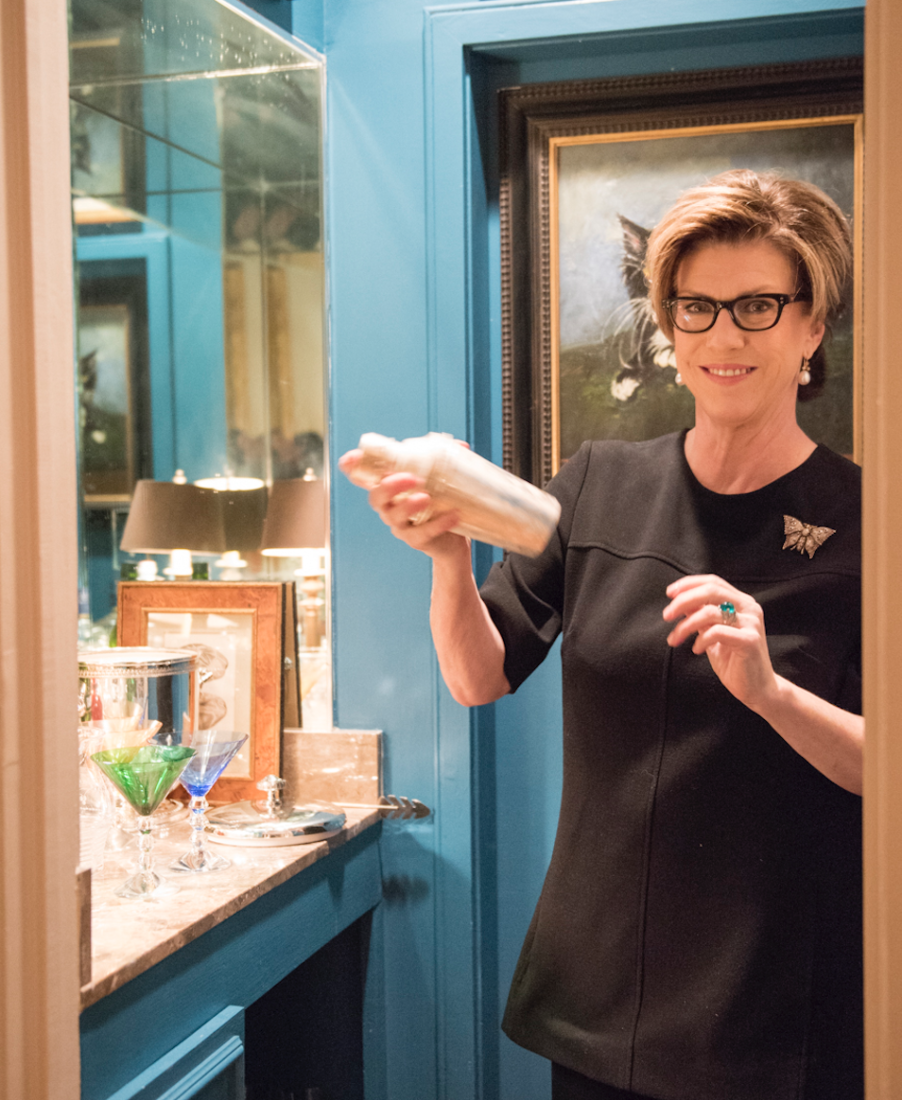Editor’s note: The following originally appeared in Garden & Gun’s The Southerner’s Handbook: A Guide to Living the Good Life.
Once, in my very early party-giving days, I was agonizing—on the phone with my mother—over what to serve at a dinner party for a famous book critic, a stories op-ed columnist, and some of my colleagues at Newsweek’s Washington Bureau, where I worked part-time. All the guests were older than I was and, clearly, more accomplished; I was still in college, lived in a three-room walk-up, and had exactly one byline to my name. But I could cook, and for weeks I’d been clipping recipes from the food pages of the New York Times, mostly overthought and fairly soulless stuff under the heading “Novelle Cuisine,” which had just been invented.
Anyway, long distance cost a lot of money back then, and I was driving my mother crazy with a long list of choices that must have sounded pretty terrible because finally she interrupted me and said, “Why don’t you just serve something that tastes good?” I have told this story many times, but it bears repeating because I took it to heart, and almost twenty years later—after I’d served a whole menu of things that tasted good at a party in my Manhattan apartment to a crowd that included an editor from the New York Times Magazine—I ended up writing about food for the very paper from which I once cut out all those pompous recipes. The editor who hired me apparently had never seen a pimento cheese sandwich or a deviled egg or a fat piece of rare beef tenderloin on a hot yeast roll until that night, and it impressed him. It impresses most people, which is why my mother’s long-ago advice remains my first rule of throwing a good party: The food does not need to be formal or “fancy” or even necessarily expensive to have an impact. In fact, the opposite is usually the case.
For example: Journalist and famed D.C. hostess Sally Quinn tells a story about a night when the caterers screwed up the date of a formal dinner and she had the bright idea to send the babysitter to Popeyes. Chicken and biscuits and red beans and rice were piled into pretty silver, the guests took seconds and thirds and demanded to know the name of the cook, and even the most august cabinet members took off their ties and rolled up their sleeves so as to better get at the good stuff in front of them. Quinn says that her male guests kiss her when she serves mashed potatoes; I get the same response to squash casserole and cheese spoon bread. But this kind of “simple” food takes a certain amount of fearlessness. During my first ever summer in the Hamptons, I was told by the formidable wife of an editor friend that under no circumstances could I serve the pot of seafood gumbo and platters of fried chicken and potato salad I’d planned on having at my debut gathering. “That’s not what we do here,” she said, instructing me instead to have a seated supper of plain grilled swordfish that was as ubiquitous that summer as shoe leather, and just as tasteless. I was slightly terrified, but I ignored her and I’ve never seen people so happy. By offering up an exotic (to them) antidote to the asceticism to which they’d unwittingly been subjected weekend after weekend, I set a tone I hadn’t even realized I was setting. They drank more and laughed louder, ate the chicken with their fingers, and stayed very, very late (except for the aforementioned arbiter who ostentatiously refused to eat a morsel and left her grateful husband behind when she drove home in a snit).
It was then that I realized that every party should be an antidote—to boring everydayness, to toil and strife, to clean living or the opposite lure of TiVo and takeout Chinese. A good party should enable you to step outside your humdrum existence and into a virtual theater of someone else’s creation, a stage set that encourages you to be your best, most hopeful self. And that does not happen when bossy, humorless hosts or hostesses put you on accidental diets or orchestrate the conversation. The two words I feared most during the years I lived in New York City were “table talk.” At one point during the meal, a glass would be clinked, and the dread words would be uttered. Each guest was then obliged to offer up his or her opinion on the latest Supreme Court nominee or some equally contentious subject, a forced march that completely shut down all the things that make being around a dinner table worthwhile: witty repartee, serious flirtation, an actually impassioned argument that ends in good-natured bread pelting rather than oration about the state of the latest immigration bill.
Those table-talk evenings always led me to the nearest post-party saloon where I could have a real conversation and enough booze to get over the previous hours’ trauma. Which leads us to the next and most important rule. It is not possible to overbuy the whiskey and wine, and both should be easily accessible from moment one of the event. To that end, there is not a thing wrong with offering people a pre-drink drink, a flute of champagne, say, or a special cocktail mixed up for the occasion and served on a tray (preferably by an actual person) just outside or inside the door. This eliminates any initial stress on the part of your guest and enables festive and well-lubricated passage along the way to the actual bar. If you’ve got a packed house, make sure you have circulating waiters taking more orders once at the table; no one should ever have to ask for more wine. By far the most useful gifts my mother ever gave me were a pair of Irish crystal wine decanters that hold almost four bottles apiece. People reach over and refill—a lot—but the wine’s still there. It’s like the miracle of loaves and fishes but no one sees the magic. Which is the point. Most people don’t want to be reminded that they’re pounding down a bottle or two of wine all by themselves. They sort of don’t want to be reminded that they are drinking at all, rather that they are simply morphing into their most lively and charming and brilliant selves, sort of like Romy and Michele in the high school reunion dream sequence where they look really hot and explain how they invented Post-it notes, complete with the formula for the glue.
But back to the stage set. Outdoor lanterns are always festive; inside, candles are a must. Flowers too, but just as the food should not be too fussy, do not have someone come in and do your house up as if a bride is about to emerge from upstairs on the arm of her father, or worse, someone has died. If you have a yard, use it. My mother has done amazing things in her time with not much more than johnsongrass, and my own favorite trick is to smash grocery store lilies or roses or whatever looks pretty into a collection of julep cups or wine rinsers on the table.
Music is also a must. I once hired a Cajun band whose washboard player did backflips across the stage. That definitely got things going, but you could also press into duty your piano-playing best friend to reinvigorate the after-dinner crowd with a rousing version of “Twist and Shout” or “What’d I Say.” There is scarcely a woman alive who does not secretly fancy herself a Raelette, and a generous host or hostess will give her the opportunity.
Finally, if the occasion demands it, have a toast ready, but for God’s sake make it funny—and short. At the rehearsal dinner the night before my good friend Anne McGee’s first wedding (an occasion she now refers to as “My Big Party”), all the super-serious friends and relations of her Yankee groom went on so long that the bride’s brother-in-law passed out at the head table during a recitation of Rudyard Kipling and her uncle finally yelled “Bullshit!” during an especially fawning tribute that made the groom out to be something other than the man-child we knew him to be. The rest of us gave Anne just the right amount of grief in the form of brief musical tributes and suitably hilarious stories that entertained our own selves and (almost) everyone else in attendance.
On the day of the wedding, my parents threw a wedding lunch at which the backyard crowd looked a tiny bit like the Red Sea, featuring the (by now forewarned) Yankees on one side and the rest of us on the other. Not surprisingly, one side stayed later than the other, so that I was late arriving at the bride’s house for the ceremony itself. As I slipped inside, I noticed the McGees’ good-looking neighbor in front of me wearing a sexy chiffon cocktail dress accentuated by a pair of evening sandals, the straps of which she had tied together and slung over her shoulder. She’d been to a great many of Anne’s mother’s big parties and well knew the fun she was going to have. Why slow things down later when you can have your dancing feet at the ready? This is hopeful, this is what you aim for, this is the sign of a very good party to come.








